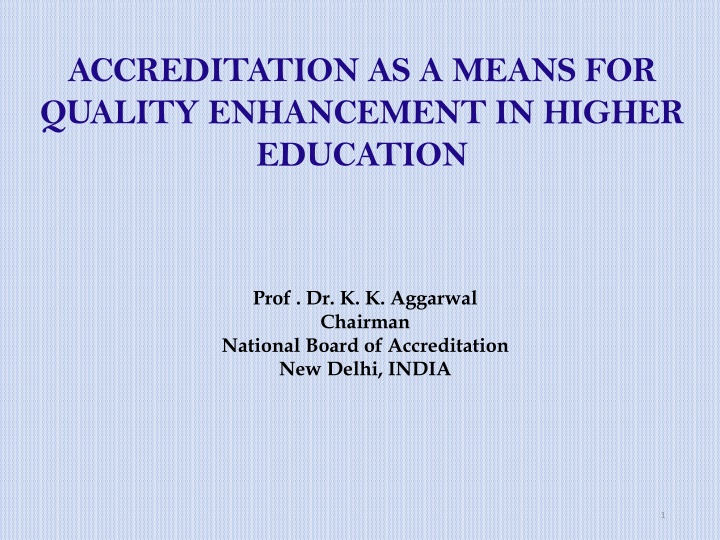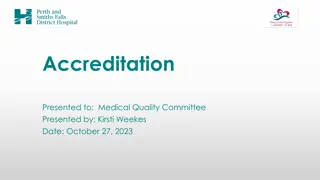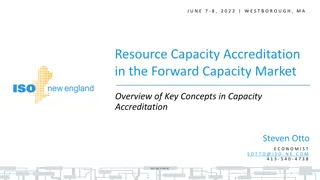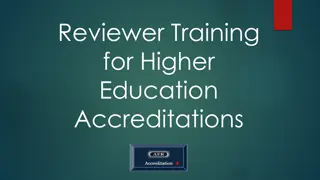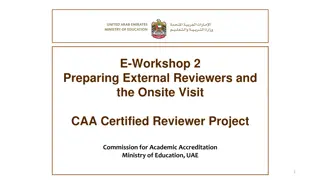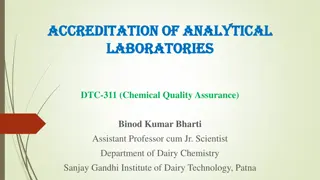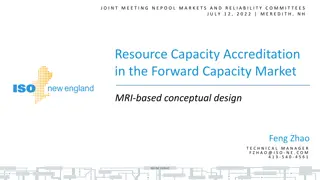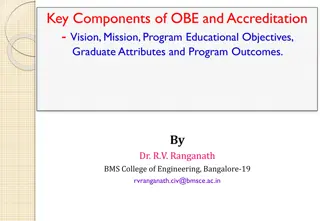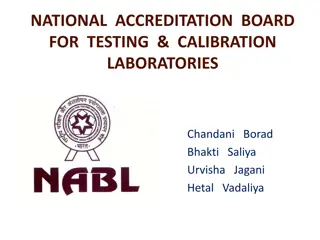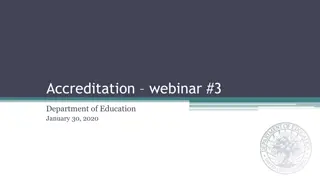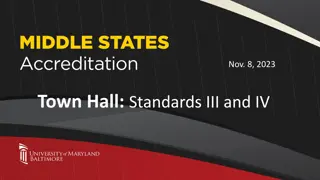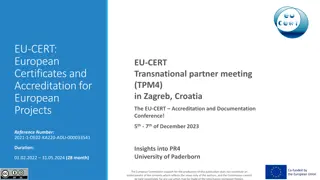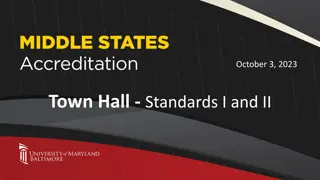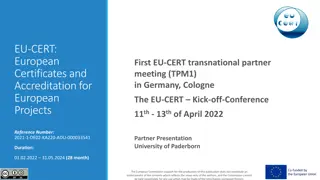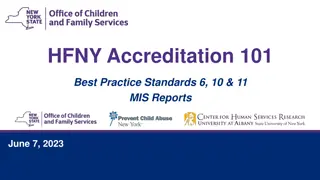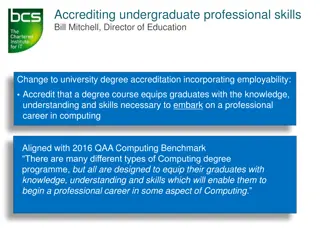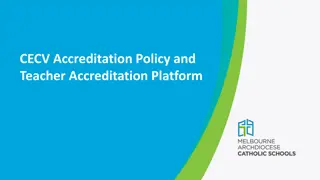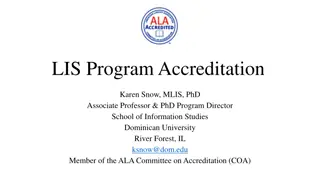Enhancing Quality in Higher Education through Accreditation and Innovation
Accreditation plays a crucial role in enhancing quality in higher education, as indicated by Prof. Dr. K.K. Aggarwal. The focus is on exploring new models like Outcome Based Education (OBE) to align learning with expectations. The demands of the global knowledge economy emphasize creativity, collaboration, and sustainable development goals, necessitating a shift towards lifelong learning approaches.
Download Presentation

Please find below an Image/Link to download the presentation.
The content on the website is provided AS IS for your information and personal use only. It may not be sold, licensed, or shared on other websites without obtaining consent from the author.If you encounter any issues during the download, it is possible that the publisher has removed the file from their server.
You are allowed to download the files provided on this website for personal or commercial use, subject to the condition that they are used lawfully. All files are the property of their respective owners.
The content on the website is provided AS IS for your information and personal use only. It may not be sold, licensed, or shared on other websites without obtaining consent from the author.
E N D
Presentation Transcript
ACCREDITATION AS A MEANS FOR QUALITY ENHANCEMENT IN HIGHER EDUCATION Prof . Dr. K. K. Aggarwal Chairman National Board of Accreditation New Delhi, INDIA 1
Accreditation and Ranking NBA & NAAC Tier I & Tier II Washington Accord Autonomy of Institutions Affiliated Institutions More Tiers & Levels Out of the box approach 2
Over emphasis on Accreditation Slow change dynamics Industry - AICTE - NBA Accreditation should peep into the future Mechanisms for Exploration Stake holder perception Should be a pleasure & not a stress Future is too near Our speed of change has to be more than the inherent speed of the change 3
Size of the Higher Education System in India TOTAL ACCREDITED APPROX % AGE % AGE IN A UNIVERSITIES >900 <400 35 60 COLLEGES >40,000 <700 14 25 Includes : i. Central Universities ii. State Universities iii. Private Universities iv. Deemed Universities v. Institutions of National Importance 4
Quality is a general concept. Quality in Higher Education Quality vis-a-vis Expectations OBE becomes relevant 5
Demands of Global Knowledge Economy Creativity, Application, Analysis and synthesis and collaborative learning. Workforce capable of retaining and learning new skill/competencies. Awareness of, Sensitivity towards and Implementation of Sustainable Development Goals. Conventional approach: treating education as transmission of expert knowledge (not suitable). 6
So a new model of education and training is required, which will focus on what is learnt & will take care of instilling lifelong learning. The New Approach 1) Decide about what you want your students to do? 2) Orient your teaching and other academic processes to do so. 3) Assess the achievement of students. 4) Improve. [ The model of education based on the above approach is called as Outcome Based Education (OBE). 7
Philosophy of OBE Bottom Up < > Top Down Measurement of Tangibles v/s Intangibles Recipe for a dish > Taste Teaching Curriculum > Learning Norms & Standards > Quality Examples : Building Design Town Planning Laying of a Rail Track Circuit Design 8
Learning Environment Required for OBE 1. Maintaining learning outcome statement/s to make explicit what the student is expected to know, understand or do. 2. Providing for learning activities in the form of group projects, seminars, fieldwork etc. which will help the student to reach these outcomes. 3. Assessing the extent to which the student meets these outcomes through the use of explicit assessment criteria. 4. Taking corrective action. 9
To implement outcome based education by making changes in: i. Course Content ii. Teaching Learning Methods iii. Assessment and Evaluation Tools iv. Data & Evidence Collection And to implement continuous quality improvement Outcome Based Accreditation In the outcome based accreditation, focus remains on evaluation of outcomes of the program, though input and output parameters are also important 10
Graduate Attributes Graduate attributes form a set of individually assessable outcomes that are the components indicative of the graduate's potential to acquire competence to practice at the appropriate level. The 12 Graduate Attributes of Washington Accord are: 1. (KB) A knowledge base for engineering 2. (PA) Problem analysis 3. (Inv.) Investigation 4. (Des.) Design 5. (Tools) Use of engineering tools 6. (Team) Individual and teamwork 7. (Comm.) Communication skills 8. (Prof.) Professionalism 9. (Impacts) Impact of engineering on society and the environment 10.(Ethics) Ethics and equity 11.(Econ.) Economics and project management 12.(LL) Life-long learning 11
Criteria for Evaluation Criteria No. Criteria Summary 1 Vision, Mission and Program Educational Objectives 2 Program Curriculum and Teaching Learning Processes 3 Course Outcomes and Program outcomes 4 Students performance 5 Faculty Information and Contribution 6 Facilities and Technical Support 7 Continuous Improvement 8 First Year Academics 9 Student Support Systems 10 Governance, Institutional Support and Financial Resources 12
Size of the NBA Problem In the face of Mandatory Accreditation About 10000 Institutions Approx 3500 Engineering 3000 Diploma Engineering 3500 MBA, MCA, Pharmacy, Architecture Average Number of Program per institution Approx. 5-6 UG+PG per Degree Engineering Approx. 3-4 per Diploma Engineering Approx. 1-2 for others 13
Total Number of programs to be Accredited: About 19K for Degree Engineering 10K for Diploma Engineering 6K for others 35K Total Cycle Time Of Accreditation: 3 years for 95% cases approx. and 6 years for the rest Translates to approx. 11000 programs per year. 14
Delivering a solution that is unique to each customer is more important than a standard solution with virtually perfect quality. The quality of innovation becomes a differentiating factor. Thus, the business will have to comprehend that quality improvement will IMPROVEMENT. mean INNOVATION 15
Creativity is hardwired into everyones brain. The challenge is to unleash this all-too-often untapped potential. The challenge is to combine people s talent with their passion. This connection between big picture and details inspires breakthroughs in every kind of field. Creativity flourishes neither in complete chaos nor in complete order. 16
Creativity, it seems, flourishes when people see not just the individual trees but the forest as well. Insights enabling a breakthrough-- these will occur when routines are broken. when the mind is not focusing on the problem at hand. The great mathematician Paul Erdos puts it A mathematician is a machine for turning Coffee into theorems. 17
The need to be right all the time is the biggest bar there is to new ideas. It is better to have enough ideas for some of them to be wrong than to be always right by having no ideas at all. - Edward D. Bono 18
ANAMOLIES 1. Increased GER 2. Mandatory Accreditation 3. Non formal Education 4. Degree of specialization 5. Cost of Education 19
Time-Based vs. Outcome-Based Framework Industrial Age Paradigm Calendar Defined Constrained Opportunity Custodial Credentialing Content Segmentation Curriculum Coverage Cumulative Achievement C lection Categories Contest Learning Comparative Evaluation Cellular Structure 20
Information Age Paradigm Outcome Defined Expanded Opportunity Performance Credentialing Concept Integration Instructional Coaching Culminating Achievement Inclusionary Success Cooperative Learning Criterion Validation Collaborative Structure 21
